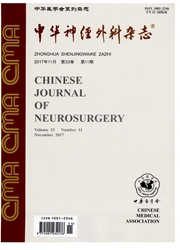

 中文摘要:
中文摘要:
目的探讨2006~2014年神经外科术后脑脊液中培养阳性患者的革兰阴性菌的种类分布及其耐药性的变化规律。方法收集2006年1月至2014年12月首都医科大学附属北京天坛医院神经外科术后脑脊液培养阳性患者的革兰阴性菌种类分布及其药敏试验结果。结果脑脊液培养阳性分离株共3220株。其中革兰阴性菌891株,占27.7%,主要包括肺炎克雷伯菌、鲍曼不动杆菌、铜绿假单胞菌及大肠埃希菌等。2006~2014年革兰阴性菌感染比例由11%升高至28%,而脑脊液培养分离得到的革兰阴性菌对抗生素的敏感率呈下降趋势。结论2006年1月至2014年12月,神经外科术后中枢神经系统革兰阴性菌感染呈现上升的趋势;在耐药菌的检测方面,由于泛耐药菌如鲍曼不动杆菌与肺炎克雷伯菌的出现,抗生素对神经外科术后革兰阴性菌感染的疗效不容乐观。
 英文摘要:
英文摘要:
Objective To investigate the distribution of species and its change rule of drug resistance of gram-negative bacteria isolated from cerebrospinal fluid in patients after neurosurgieal operation from 2006 to 2014. Methods The distribution of species of cerebrospinal fluid cultured gram-negative bacteria and its drug sensitivity test results of the patients after neurosurgical operation in Beijing Tiantan Hospital, Capital Medical University from January 2006 to December 2014 were collected. Results There were a total of 3 220 cerebrospinal fluid cultured positive isolates, including gram-negative bacteria 891 isolates, accounting for 27.7%. After neurosurgieal operation, the infected cerebrospinal fluid cultured positive gram-negative bacteria mainly included Klebsiella pneumoniae, Acinetobaeter baumannii, Pseudomonas aeruginosa, and Escherichia coli, etc. The proportion of gram-negative bacteria infection increased fi'om 11% in 2006 to 28% in 2014, and the gram-negative bacteria cultured and isolated from cerebrospinal fluid for the antibiotic sensitivity showed a downward trend. Conclusions From January 2006 to December 2014, gram-negative bacterial infection showed an upward trend after neurosurgical procedure. In the detection of drug-resistant bacteria, the efficacy of antibiotics for gram-negative bacteria infection was not optimistic after neurosurgical procedure, because the appearance of pan-drug resistant bacteria, such as Acinetobacter Baumanii and Klebsiella pneumoniae.
 同期刊论文项目
同期刊论文项目
 同项目期刊论文
同项目期刊论文
 期刊信息
期刊信息
